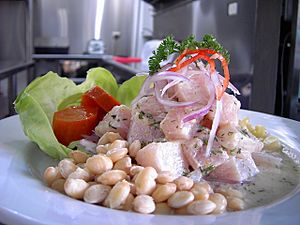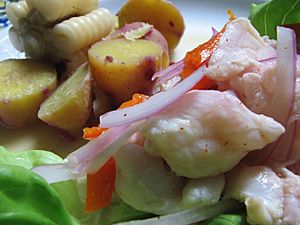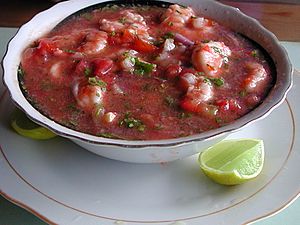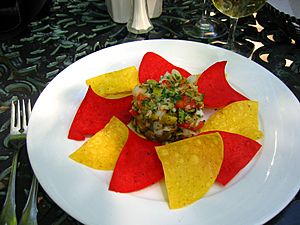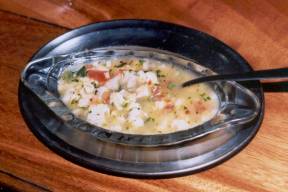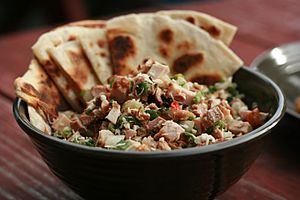Ceviche facts for kids
|
Peruvian ceviche
|
|
| Course | Main course, appetizer |
|---|---|
| Place of origin | |
| Serving temperature | Cold; cooked or raw (marinated) |
| Main ingredients | Fish, lime, lemon, onion, chili pepper |
Ceviche (also spelled cebiche, seviche, or sebiche) is a yummy seafood dish that started in Peru. It's usually made with fresh, raw fish that has been "cooked" in citrus juices, like lemon or lime. It gets its flavor from spices like ají (a type of chili pepper), other chili peppers, chopped onions, salt, and cilantro.
Because ceviche isn't cooked with heat, it's very important to make and eat it fresh. This helps make sure no one gets sick from the food. Ceviche often comes with tasty side dishes that go well with its flavors. These can include sweet potato, lettuce, corn, avocado, or plantain. This dish is very popular in countries along the Pacific coast in Latin America. While people discuss where ceviche truly began, in Peru it is seen as a national dish.
Even though old records suggest a dish similar to ceviche might have been eaten in Peru almost 2,000 years ago, some historians think the idea for the dish came to Peru with women from Granada, Spain. These women traveled with the Spanish explorers and settlers. Over time, this dish changed and became what we now call ceviche. A famous Peruvian chef named Gastón Acurio explains that because Lima was the capital of the main Spanish colony in Peru for 400 years, popular dishes like ceviche spread to other Spanish colonies. Eventually, these dishes became part of the local food in those places, with new flavors added.
Today, ceviche is a popular dish all over the world. It came to the United States in the 1980s. You can find the most different kinds of ceviche in Ecuador, Colombia, Chile, and Peru. But unique styles are also found in places like Honduras, El Salvador, Belize, Guatemala, Mexico, Panama, and other countries.
History of Ceviche

Marlin Kilawin from the Philippines
|
People have different ideas about where ceviche first came from. Some old stories from Peru say that ceviche started with the Moche people. They were a coastal group who lived in northern Peru almost 2,000 years ago. The Moche people may have used fermented juice from a local fruit called banana passionfruit.
Newer studies also show that during the Inca Empire, fish was marinated with chicha. This is a traditional Andean drink made by fermenting plants. Other old writings say that people along the Peruvian coast ate fish with salt and ají (a chili pepper) before Europeans arrived. This idea suggests that when the Spanish brought citrus fruits, the native people simply started using them instead. But the main parts of the dish stayed the same. In Ecuador, ceviche might also have started with its own coastal groups. This is because Peru and Ecuador share cultural history, like the Inca Empire, and both have many kinds of fish and shellfish.
Other Possible Origins
The old kinilaw (or kilawin) dish from the Philippines is very similar to ceviche. It is another possible origin for the dish. Many in Mexico believe this is where ceviche came from. This is especially true because citrus fruits, which are not originally from the Americas, are native to the Philippines. Kinilaw has many different versions in the Philippines. We know it existed from archaeological findings dating back to the 10th to 13th centuries AD. It was also brought to Guam, where it became kelaguen. Both the Philippines and Guam were on the trade route for Spanish ships called the Manila Galleons.
Some people even think ceviche was invented in places from Central America to the Polynesian islands in the South Pacific. Ceviche is not originally from Mexico, even though it has been a part of traditional Mexican coastal food for hundreds of years. The Spanish, who brought citrus fruits like lime from Europe, might have brought the dish from Spain. In Spain, it might have had roots in Moorish cooking.
Peruvian Origin Theory
However, most historians agree that ceviche began during the time of Spanish rule in what is now Peru. They believe that the dish's early form was brought to Peru by women from Granada, Spain, who traveled with the Spanish. This dish then slowly changed into what we know as ceviche today.
Peruvian chef Gastón Acurio further explains that Lima was the most important city for the Spanish in Peru for four centuries. This allowed popular dishes like ceviche to spread to other Spanish colonies in the area. Over time, these dishes became part of the local food by adding regional flavors and styles. Other famous chefs, like Christopher Carpentier from Chile and Ferran Adrià from Spain, also support the idea that ceviche started in Peru. Ferran Adrià once said, "Cebiche was born in Peru, and so the authentic and genuine [cebiche] is Peruvian."
Images for kids
-
"Alaskan" Ceviche made with Pacific halibut, serrano peppers, cilantro and tomato
See also
 In Spanish: Cebiche para niños
In Spanish: Cebiche para niños


